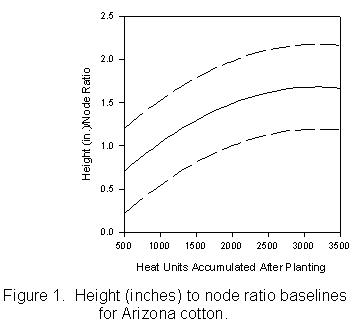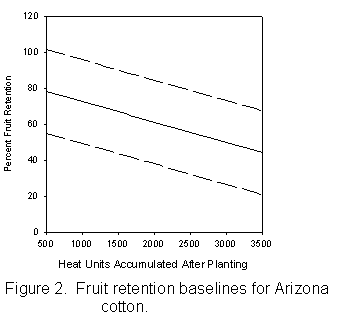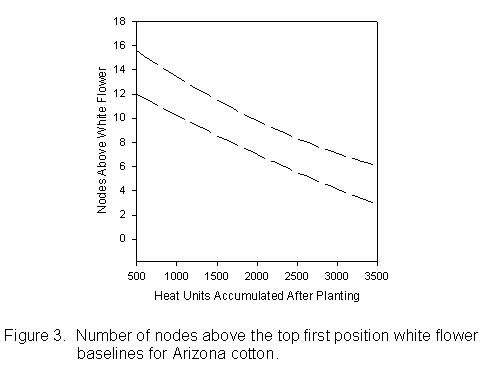Evaluating Early Season Crop Condition and Potential
by Jeffrey C. Silvertooth,
Extension Agronomist - Cotton
To say that the Arizona cotton crop is behind at this date is somewhat of an understatement. In most years, many fields in Arizona are rapidly blooming by this date, but most fields are just now setting squares. The low desert areas (Yuma Co.) have the most advanced crop in the state, but many fields are experiencing delays due to late fruiting branch formation (> eighth node; associated with cool and fluctuating spring weather) and early square loss. The counties in the mid-level elevations (Maricopa, Pinal, La Paz, Mohave, and Pima) have really been struggling with poor crop vigor, slow development, highly variable stand conditions, and excessive terminal damage (up to 80% averages in some cases, from a combination of wind and insect damage). Probably the best crop conditions in the state at this time are in the higher elevation valleys (3,000 ft. +).
Not only do we have a delayed crop in many of these areas due to the difficulties encountered during the planting season, we are now experiencing further delays in crop development due to the early season terminal damage, delays in fruiting branch formation, and/or high rates of square abortion. Many fields in the mid-level elevations of central Arizona, were planted in April. With the slow early-season crop development that we have been experiencing, however, many of these fields are at a stage of growth commonly associated with a May planting date. Based upon date of planting research, medium to full season varieties (i.e. DP 5415) planted during early May in central Arizona will experience a 20% decrease in yield potential compared to an early to mid-April planting date. Determinant varieties (i.e. STV 474, SG 125, DP 20) will often show a 10% decrease in yield potential from this type of planting date comparison. It is difficult to extend results from earlier research to predict potentials in a season like this, but I do feel that we could be facing 10 to 20% reductions in yield potentials (relative to normal) with the crop conditions we currently have. In many cases it could take us another four weeks to improve crop vigor and get the crop in a good fruiting mode. By that time we could be experiencing a summer monsoon, which could further diminish fruit retention (FR) and yield potential. This could result in a very late season for many fields to establish a decent fruit load and yield potential, assuming we would have the benefit of weather conditions conducive for a late season. This could translate into a very expensive crop. With the current market and economic conditions this means that field evaluation and management will be increasingly critical.
Important factors to consider in monitoring fields each week of the season will include: crop vigor (height to node ratios, HNR, Figure 1), FR (Figure 2), and stage of growth. An easy measure for estimating the stage of growth for cotton is by counting the number of nodes above the top (first position) white flower (NAWF). Guidelines relative to NAWF counts and stage of growth for Arizona cotton are well established (Table 1). Figure 3 provides a graphical outline (normal "glide path") of NAWF values one can expect in relation to heat units accumulated after planting (HUAP). Basically, NAWF counts should not drop below the lower baseline shown in Figure 3, which would indicate reduced vigor and fruiting potential, and an accelerated approach to cut-out.
Management decisions for crop inputs such as irrigations, pest control, fertilizers, and PIXtm need to always be based upon actual crop conditions. In a season like this, there is no time for compensation and very little room for error. This means that regular (weekly) crop monitoring and evaluation can be very constructive to maintaining good control of the crop and realizing as much as possible from the yield potentials that are offered by this season.
Table 1. Important growth stages for cotton development.
| Stage |
|||||||
| PHS |
MHS |
FB |
EB |
PB |
Cut-out |
|
|
|---|---|---|---|---|---|---|---|
| HUAP | 700 |
900 |
1200 |
1500 |
2000 |
2500 |
3000 |
| Nodes | 9 |
11 |
13 |
16 |
20 |
24 |
28 |
| NAWF | - |
- |
9-11 |
8-9 |
6-8 |
<=5 |
<2 |
Issued in furtherance of Cooperative Extension work, acts of May 8 and June 30, 1914, in cooperation with the U.S. Department of Agriculture, James A. Christenson, Director Cooperative Extension, College of Agriculture and Life Sciences, The University of Arizona.
The University of Arizona is an equal opportunity, affirmative action institution. The University does not discriminate on the basis of race, color, religion, sex, national origin, age, disability, veteran status, or sexual orientation in its programs and activities.
Any products, services, or organizations that are
mentioned, shown, or indirectly implied in this web document do not imply
endorsement by The University of Arizona.
Information provided by Jeffrey C. Silvertooth, silver@ag.arizona.edu
Extension Agronomist - Cotton, College of Agriculture, The University of Arizona.
Material written 12 June 1998.
Home | Cotton | Advisories
document located at: http://cals.arizona.edu/crops/cotton/comments/june1998cc.html
Copyright © 2001 University of Arizona,
College of Agriculture and Life Sciences
Webmaster: Al Fournier (acis@ag.arizona.edu)


